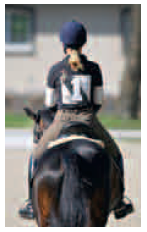When you ride, whatever your discipline, you are forever asking the horse to flex this way, or that way, or a little less, or a little more.

So what is flexion, anyway? It’s time to rid your mind of any images of muscle-bound forelegs striking Arnold Schwarzenegger poses! Flexion, when riding, is usually about lateral positioning of the second cervical neck joint, an area we commonly refer to as part of the horse’s “poll.”
It should be noted that lateral flexion is not the same thing as lateral bend—the latter involves the entire horse, from nose to tail, and allows the horse to be “straight” on curved lines (as confusing as that sounds) with his his hind feet following in the tracks of the fore.
In the new book RIDER+HORSE=1, authors Eckart Meyners, Hannes Muller, and Kerstin Niemann explain how the horse must be flexed as well as bent when you ride a curved line such as a circle or a turn. “To do this,” they write, “you turn the horse’s head just enough to be able to see–from your position on the horse’s back–the inside eye and nostril. The horse’s ears remain at the same level and the crest tilts into the direction in which the horse is being flexed. Flexion only pertains to the front of the horse, meaning head, poll, and neck.”

Step-by-Step Flexion of the Horse from RIDER+HORSE=1
The basic sequence of flexing the horse can be divided into four steps:
1 Request Flexion: You slightly shorten the inside rein. As long as flexion is only requested, your weight remains equal on both sides with your driving aids matching the gait and direction.
2 Allow Flexion: You must now allow with the outside rein the extent of flexion you just requested with the inside rein. This means you must lengthen the outside rein to the same extent that the inside rein is shortened.
3 Limit Flexion: The outside rein, however, also has the task of not allowing unlimited flexion–it dictates how far the horse should flex in his poll and neck.
4 Yield with the Inside Rein: According to the principle of diagonal aids, you now continue to guide the flexed horse on the outside rein and slightly yield with the inside rein (which had initially
asked for flexion). In this situation, your inside driving leg is of special significance while your outside leg “guards” and drives the horse forward.
For more ways you can achieve a fluid dialogue and harmonious performance with your horse, check out RIDER+HORSE=1, now available at the TSB online bookstore, where shipping in the US is FREE.

